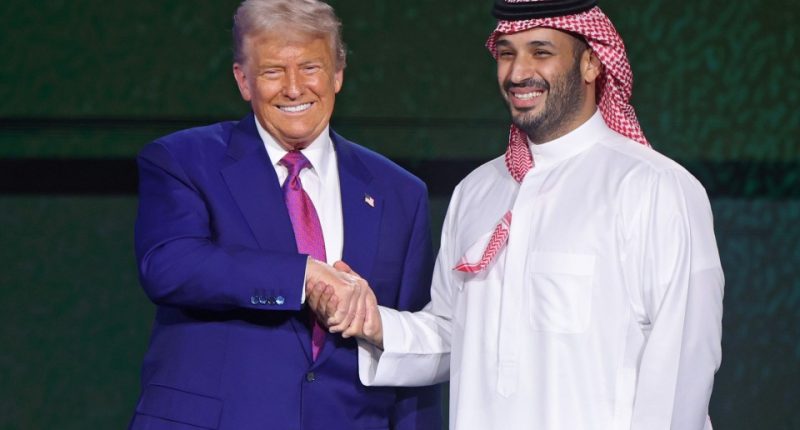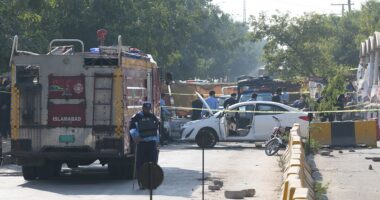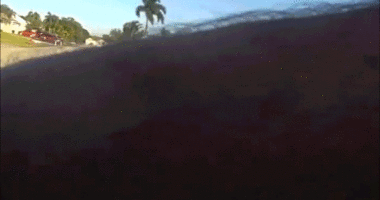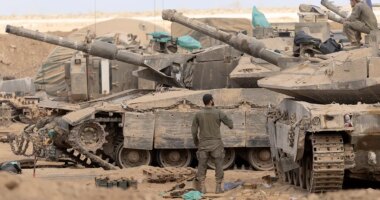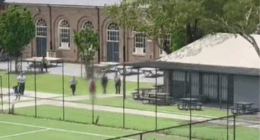Share this @internewscast.com
THE US and Saudi Arabia have signed a historic $600 billion deal between the two nations which includes a massive arms package.
There are reports that fighter jets, sophisticated missile systems, and reaper drones are included in the $142 billion defense deal finalized by Donald Trump and Mohammed bin Salman on Tuesday.

The bumper deal has been described as “historic and transformative” for both countries, according to the White House.
It also welcomes in a “new golden era of partnership” between Washington and Riyadh.
Part of the agreement includes the “largest defence sales agreement in history” made up of the $142 billion.
According to Washington, the deal features “state-of-the-art war fighting equipment” alongside numerous services from American defense companies like Lockheed Martin and Boeing.
Both parties have remained tight lipped over what the deal actually encompasses in terms of the weapons being exchanged.
But several reports have now unveiled what is expected to be a part of the package arms deal.
The main focus of the strengthening partnership is to help enhance Riyadh’s air, missile, and naval defences.
And ensuring “extensive training and support” is given to the Saudi armed forces, according to the White House.
Trump is keen to help promote stability in the Gulf region amid looming threats from Iranian terror proxies such as the Houthis.
Lockheed C-130J military aircraft
A key component of the deal is said to be Washington’s C-130J Super Hercules transport aircraft from Lockheed Martin.
The military crafts are specially designed for desert operations as well as logistical support.
The modern version of the C-130’s can carry up to 44,000 pounds of cargo or transport 90 troops.
They also boast a range of 2,000 miles and are made to operate on short runways to allow for a quick takeoff at any moment.
The C-130J planes are equipped with advanced avionics systems, which incorporate digital displays and improved navigation systems, making them particularly well-suited for the challenging conditions of the Gulf region.
Saudi Arabia has experience using earlier C-130 models as they helped to send supplies as part of humanitarian missions in Yemen in recent years.
Another key feature of the new military aircraft is there transferable data systems with Nato equipment.
This means Riyadh can exchange information with Western forces – such as the US – as part of its interoperability system.
THAAD anti-ballistic missile defence system
One of the major areas in which Saudi Arabia is set to benefit from the package deal is through its air and missile defence systems.
This means the Terminal High Altitude Area Defense [THAAD] system is believed to be among the items being sent to Riyadh.
Produced by Lockheed Martin, the THAAD is designed to intercept and destroy short and medium-range ballistic missiles during their “terminal” phase of flight when they are falling towards the target.
The $1billion system was developed by the Pentagon following the failure of Patriot air-defence missiles to shoot down Saddam Hussain’s Scud rockets in the first Gulf war.
THAAD missiles are 20ft long, weigh nearly a ton and fly at up to 6,300mph – more than eight times the speed of sound.
They do not carry an explosive charge because it could detonate the warhead of the missile it is targeting which could contain a nuclear device.
Instead they rely on a “hit-to-kill” approach, using infrared sensors to track the incoming missile and blasting it head-on to destroy it.
A typical THAAD battery includes at least six launcher vehicles, each capable of firing eight missiles.
Patriot PAC-3 missile system
The impressive Patriot PAC-3 is an evolution of the US Patriot system which can deploy advanced radar and interceptors to counter ballistic missiles, cruise missiles, and many types of enemy aircraft.
It can track up to 100 targets at any one time and can be paired with the THAAD system for extra effectiveness.
Saudi Arabia already use a version of the Patriot systems which have been combat tested to intercept Houthi missiles and drones.
But the kingdom is in need of a more advanced version as they have faced challenges in intercepting all enemy strikes due to the volume and unpredictability of the terror attacks.
MQ-9B SeaGuardian reaper drone
The MQ-9B SeaGuardian unmanned aerial system is also said to be included in the deal due its military success in the past.
Manufactured by General Atomics, and valued at $20 billion, the weapon is a maritime-focused variant of the Reaper drone.
It has been designed for intelligence, surveillance, and reconnaissance missions, as well as launching precision strikes.
Boasting a wingspan of 79ft and a maximum range of over 30 hours, the SeaGuardian can carry up to 5,600 pounds.
It also features advanced sensors and munition systems.
A pair of expert tracking radars also come with the plane as one allows it to detect surface vessels over the ocean.
The second uses electro-optical and infrared sensors which provide high-resolution images which can be used for targeting enemies.
The drone’s ability to reach altitudes up to 40,000ft makes them the ideal weapon for the Saudis monitoring the Persian Gulf.
F-35 stealth fighter jets
There has been speculation over the inclusion of the F-35 stealth fighter jets for weeks ever since rumours of an arms deal were first announced.
There is yet to be any confirmation around the F-35’s but the impressive weapons have been eyed up by Riyadh for some time now.
Again developed by Lockheed Martin, the jets are a fifth-generation multirole fighter which uses advanced stealth, sensor fusion, and network-enabled operations.
They also feature an AN/APG-81 radar and infrared sensors which allow it to detect and engage targets at long ranges.
Saudi Arabia’s interest in the F-35 come from them wanting to match other military operations in the Middle East who have similar impressive fighter jets.
Israel have been known to use F-35 jets to fight off Iran and their proxies across the past 18 months.
One potential issue with any war jets traded from the US to Riyadh is around long-term restrictions on exporting sensitive technologies out of Washington.
Reports suggest any deal could instead involve improving the Saudis existing fleet of fighter jets – most notably their F-15s and Typhoons.
